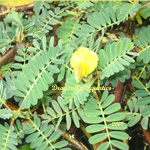 Sensitive Plant (Neptunia aquatica) is exactly like its name, sensitive to the touch and when touched its tiny leaves will contract. Did you know that it resembles a dragonfly's wings? When glancing at the leaflets, you'll notice they are growing on both sides of the petiole, and when touched resemble dragonfly wings.
Sensitive Plant (Neptunia aquatica) is exactly like its name, sensitive to the touch and when touched its tiny leaves will contract. Did you know that it resembles a dragonfly's wings? When glancing at the leaflets, you'll notice they are growing on both sides of the petiole, and when touched resemble dragonfly wings.
During the growing season the sensitive plant will grow tiny yellow flowers that are about an inch wide along the stems. You can float this plant and it will grow spreading out over the pond. It can also be rooted in soil at the edge of a pond where it will spread out over the pond and grow to about 5-6 inches tall. It requires sun to part shade and is hardy zones 9-11.
There are two type of sensitive plant, the regular and the giant sensitive plant.
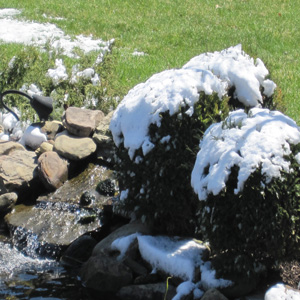 This is what some of us in the North woke up to this morning, and this was after some of it had melted. What happened to those 50 and 60 degree days??? Hopefully they will be back again soon. How can we get started cleaning our ponds and thinking putting those new plants in if the water is too cold to put our hand in it. And what about those fish and frogs???? They are hiding again.
This is what some of us in the North woke up to this morning, and this was after some of it had melted. What happened to those 50 and 60 degree days??? Hopefully they will be back again soon. How can we get started cleaning our ponds and thinking putting those new plants in if the water is too cold to put our hand in it. And what about those fish and frogs???? They are hiding again.
Whenever this happens, those of us who wanted our plants shipped thinking its finally warm wonder, now what do I do with them. Make sure you protect them by bringing them indoors until it warms up. Remember most of the plants have been indoors in a greenhouse environment and shiver even when the temps are in the 60s. But we need to make sure the water temperature have stabilized to 65 degrees before we put those floating plants out.
The floating water plants in your pond need to have the water temperature reach 65 degrees. They will show signs of yellowing leaves and black spots on their leaves if left in water temps below that. The water lettuce will wilt and turn white if too cold. We tend to get anxious in the spring and sometimes put floaters in before the water is warm enough. Even the lotus and waterlilies need the warmer weather to start growing. But at least those were outside all winter and were pulled to ship out.
Hopefully, like last year, this is a short spell and in a couple weeks things will turn around and we can once again start looking forward to enjoying our ponds.
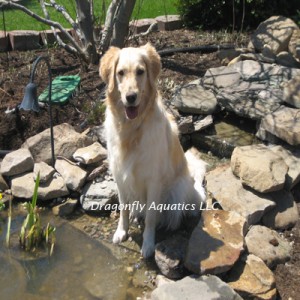 Time to spring forward, or at least turn the clocks forward! Things are beginning to warm up a bit here in the north and we are anxiously waiting for Spring to arrive so we can begin to add new plants to our ponds. Another couple of months and we will be sitting back enjoying our ponds once again. It won't be long now. For those in the warmer regions, zones 8 and above, you are putting pond plants in your ponds and starting to enjoy them, while those of us in the lower zones are still waiting. At least most of the ice has melted and we can begin thinking about our ponds once again.
Time to spring forward, or at least turn the clocks forward! Things are beginning to warm up a bit here in the north and we are anxiously waiting for Spring to arrive so we can begin to add new plants to our ponds. Another couple of months and we will be sitting back enjoying our ponds once again. It won't be long now. For those in the warmer regions, zones 8 and above, you are putting pond plants in your ponds and starting to enjoy them, while those of us in the lower zones are still waiting. At least most of the ice has melted and we can begin thinking about our ponds once again.
Don't be fooled by Mother Nature. We need to make sure it is warm enough outside, and make sure our pond water is warm enough for the plants to survive. Knowing your pond temperature is crucial, so begin by checking your pond water temperature at different times of the day. The pond water is cooler in the morning and warmer in the afternoon but will cool down again in the evening. Knowing what the consistant temperature of your pond water is important before adding the pond plants.
The first plants most of us want to put in are those that will help us keep the pond clear, such as floating plants like water hyacinths and water lettuce. Cold water will kill both of these in a matter of days if the water temperature is still too cold. We need to make sure the water temperature is consistent and reaches 65 degrees and stays there morning, afternoon and evening before we add floating plants.
There are other things we must do first that will keep us busy, such as adding beneficial bacteria to help keep our pond clear. The good bacteria, such as MicrobeLift PL neutralizes ammonia and nitrites, and will start to work when the water temperature are 50-55 degrees. If you add bacteria, it will stay in the pond and start working when the pond water is warm enough. It acts on its own and will stay un-activated until it knows to start working. For those of us who use barley, now is the right time to start adding it. This will also help retard the growth of string algae in the Spring months.
The list goes on and on. While all of us are anxious to add the pond plants there are still several things to do prior to this. I will be posting articles in the next few days with spring tips for our ponds.
Stay tuned!
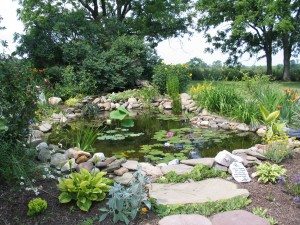 Its essential to achieve a natural ecological balance in your pond. We can achieve this naturally with a few key steps. Adding submerged plants play an important role in achieving success by removing excessive nutrients in the water and provide oxygen during the day for fish and other aquatic creatures. The most important role is removing excessive nutrients that help reduce the incidence of algae which is the nightmare of most water gardeners. They starve out the algae by utilizing all the mineral salts which the algae normally feeds from.
Its essential to achieve a natural ecological balance in your pond. We can achieve this naturally with a few key steps. Adding submerged plants play an important role in achieving success by removing excessive nutrients in the water and provide oxygen during the day for fish and other aquatic creatures. The most important role is removing excessive nutrients that help reduce the incidence of algae which is the nightmare of most water gardeners. They starve out the algae by utilizing all the mineral salts which the algae normally feeds from.
Submerged pond plants oxygenate the water during the day, but at night the process is reversed and carbon dioxide is produced. This only becomes a problem if your night time temperatures are quite warm and you overstock your pond with fish. Generally the more submerged plants you put in your pond the better the pond balance will be.
Algae likes full sunlight so in addition to the submerged plants add floating plants, waterlily foliage or bog plants to cover at least one third to one half of your pond's surface, but no more than one half to be successful in controlling the green suspended algae.
There is a balance to achieve so make sure you don't cover too much of your ponds surface with plants or it will inhibit the submerged plants from growing.
The recommendation is to have 1 bunch of submerged plants per every 2 to 3 square feet of surface area. We sell submerged plants by the bunch so you receive 6-8 plants per bunch. You can determine your surface area by multiplying your length by the width of your pond. This gives you a general idea.
A similar calculation is made to determine the quantity of floating plants and waterlilies for your pond. Determine the square footage and remember you don't want more than half of the surface covered so that the submerged plants receive plenty of light.
Once you create the formula for water clarity the rest is easy.
All plants thrive when given fertilizer. Pond plants aren't any different than our garden plants and flowers. A little tip for your water hyacinths is to take them out of your pond and place them in a tub with water and miracle grow in it. Leave them soak for awhile soaking up the fertilizing in their leaves. Rinse them off and return them to your pond. They will flower more for you. You can also do this when you first receive your plants when re-hydrating them prior to planting them or placing them in your pond.
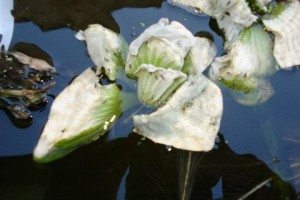 When putting floating water lettuce in your pond you need to make sure the water temps are 65 degrees or above. This is a picture of what happens to lettuce if put in water temperatures that are below that.
When putting floating water lettuce in your pond you need to make sure the water temps are 65 degrees or above. This is a picture of what happens to lettuce if put in water temperatures that are below that.
We often get anxious to start up our ponds in the spring. Especially since we need to get some coverage on it to prevent algae and get some protection for our fish. But we need to be patient and introduce those plants when the water temperatures warm up.
This is a cooler spring than normal with cold spells popping up in states that normally are warm by now. We may have hardy water lilies in our ponds that have sprouted already. Their leaves are reaching the top of the pond but they have been dormant in the cold water through the winter and now are reaching for the warm sun. The water lettuce has been in a nice warm greenhouse prior to your pond and needs to have the warmer water to flourish.
Thanks to one of our customers for sharing his picture.
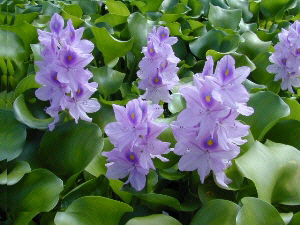 Water gardening is easy with floating plants. Just place in the water and they drift effortlessly in your pond. The roots of floating plants dangle down into the water where they draw nutrients for the plant's growth. Floating plants provide shade for your pond while creating a place for fish to hide under to protect them from the hot summer sun. They also give them a place to hide from predators, such as herons or raccoons. The greatest benefit of floating plants is they help with your ponds filtration.
Water gardening is easy with floating plants. Just place in the water and they drift effortlessly in your pond. The roots of floating plants dangle down into the water where they draw nutrients for the plant's growth. Floating plants provide shade for your pond while creating a place for fish to hide under to protect them from the hot summer sun. They also give them a place to hide from predators, such as herons or raccoons. The greatest benefit of floating plants is they help with your ponds filtration.
Some of the floating plants, such as water lettuce, water hyacinth and parrots feather are good for filtrating. Their tiny hairy roots absorb nitrates and phosphates from the water and help in creating a good filtration. By taking these nutrients in it prohibits algae growth and green water. Azolla and duckweed are also filtration plants. Your other floating plants, such as sensitive plant and frogbit will only filter nutrients from the water and don't help combat green water.
Remember not to place floating water plants in your pond until the water temperature have reached 65 degrees. They will show signs of yellowing leaves and black spots on their leaves if left in water temps below that. We tend to get anxious in the spring and sometimes put floaters in before the water is warm enough.
If you want to try and keep them over the winter you may try floating them in a tray or aquarium. Its difficult and not always successful but worth a try if you so desire. You need to keep the water around 70 degrees and they need about 12-14 hours of sunlight. With it being hard to get that much sunlight during the months of January and February you would have to keep a growing light on them about 12 inches over the water. You may find that its cheaper just to replace them yearly due to the cost of energy and electricity required to keep them growing over the winter.
Caring for these plants is minimal and a great asset for your pond. Some states discouraged or even ban them from possession due to their growth rate and spreading rate. You should never add to a natural body of water. If you aren't sure about your area make sure you compost them into your vegetable bed. You can always check with your state regarding the laws that prohibit these plants.
Buy water hyacinths-blueshellflower-floating plants here.
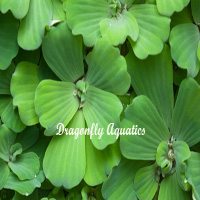 Water Lettuce (Pistia stratiotes), a floating plant that creates a natural filter in your pond while helping to combat algae and green water. Water lettuce grows like a rosette from a single crown resembling a head of lettuce. Each leaf may reach up to 12 inches in height and several inches wide and can reach 24 inches in diameter. They grow best in partial shade, especially in the hotter climates and can tolerate full shade. Water Lettuce will not tolerate cold water. It prefers water temperatures of 6o degrees and above. If you experience a late Spring freeze in your area, you should protect your Water Lettuce from the cold, by bringing it indoors during the cold spell.
Water Lettuce (Pistia stratiotes), a floating plant that creates a natural filter in your pond while helping to combat algae and green water. Water lettuce grows like a rosette from a single crown resembling a head of lettuce. Each leaf may reach up to 12 inches in height and several inches wide and can reach 24 inches in diameter. They grow best in partial shade, especially in the hotter climates and can tolerate full shade. Water Lettuce will not tolerate cold water. It prefers water temperatures of 6o degrees and above. If you experience a late Spring freeze in your area, you should protect your Water Lettuce from the cold, by bringing it indoors during the cold spell.
Buy water lettuce-pond plants here.